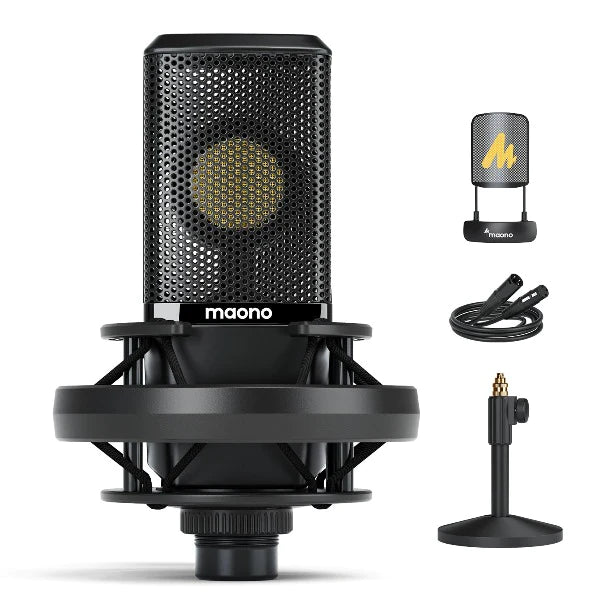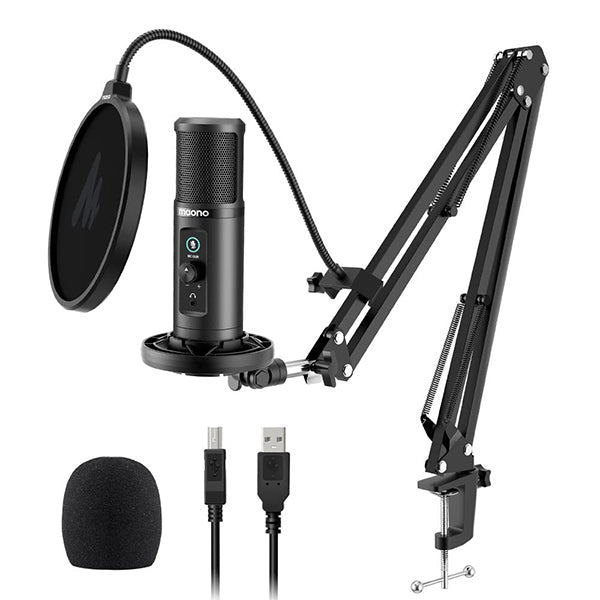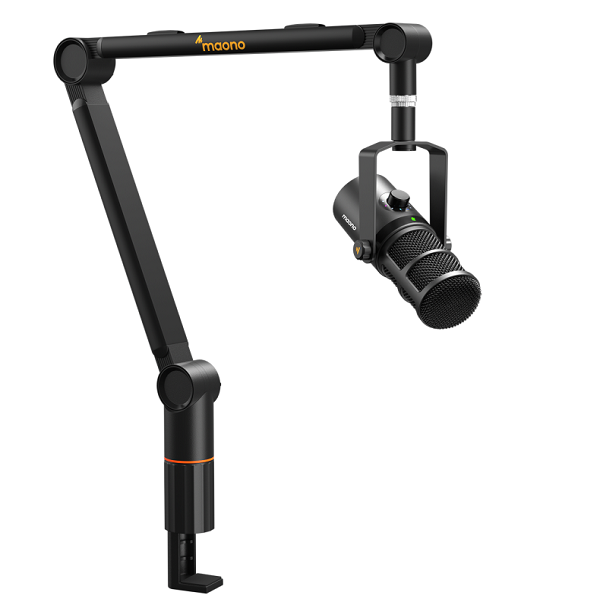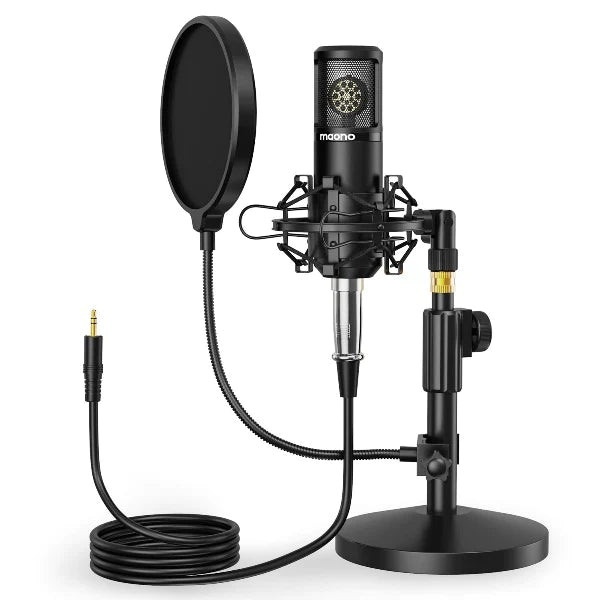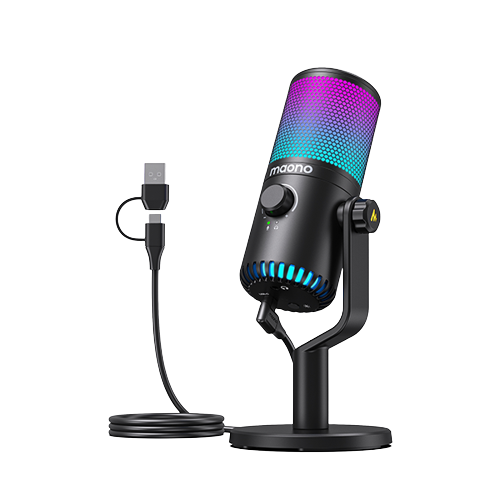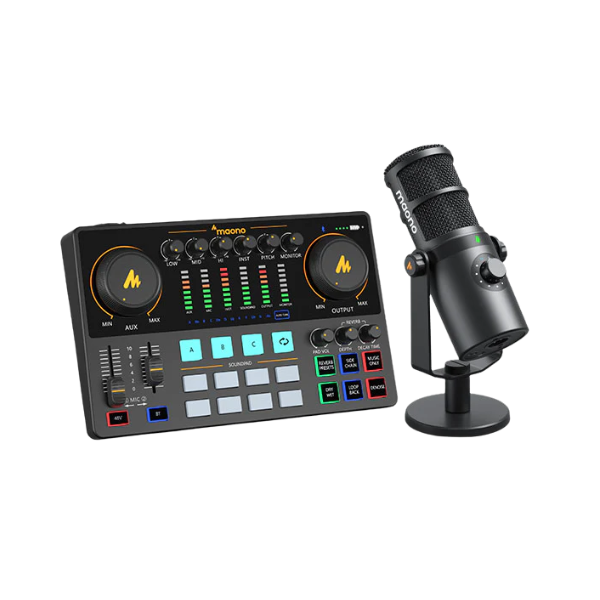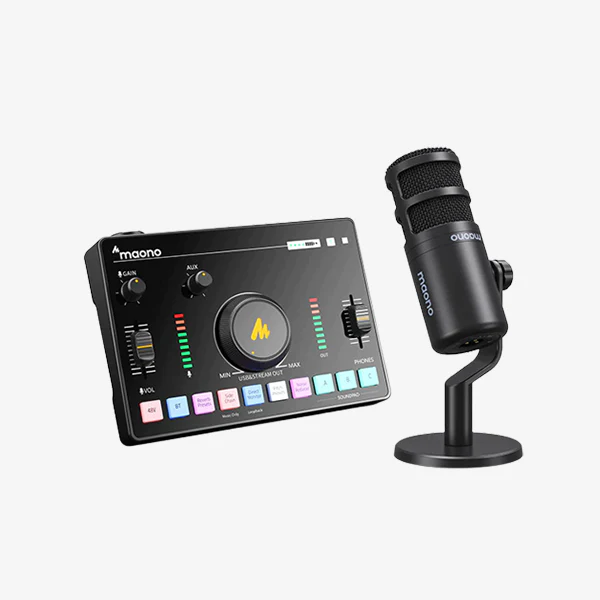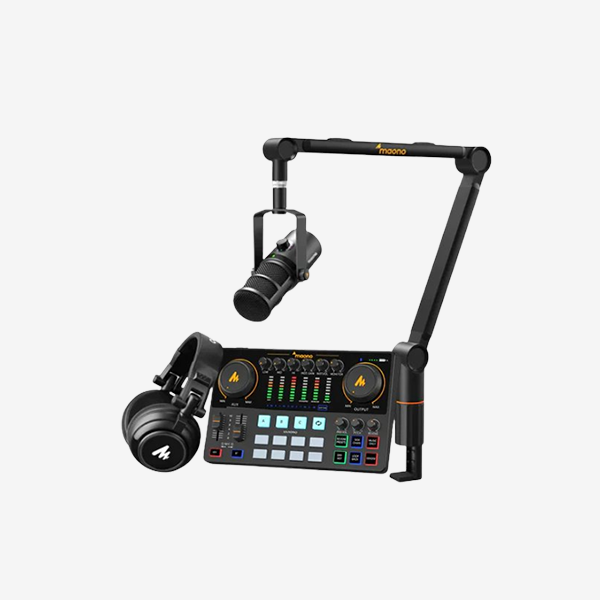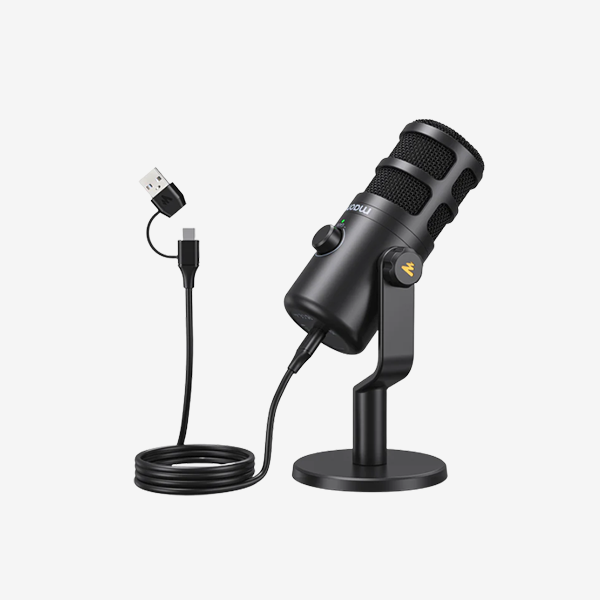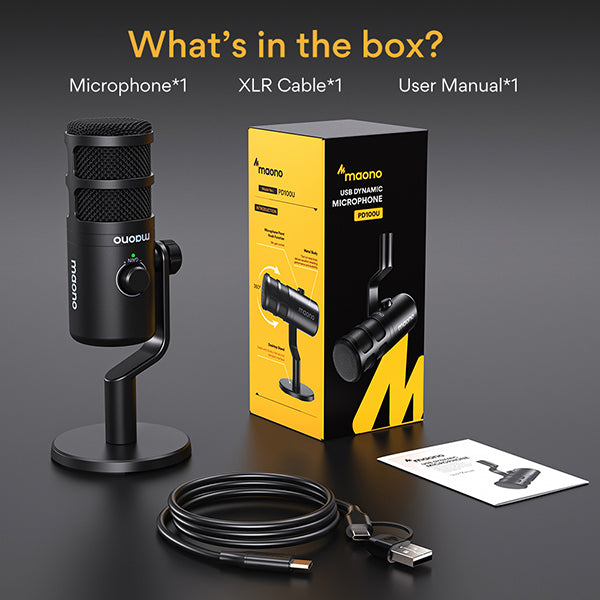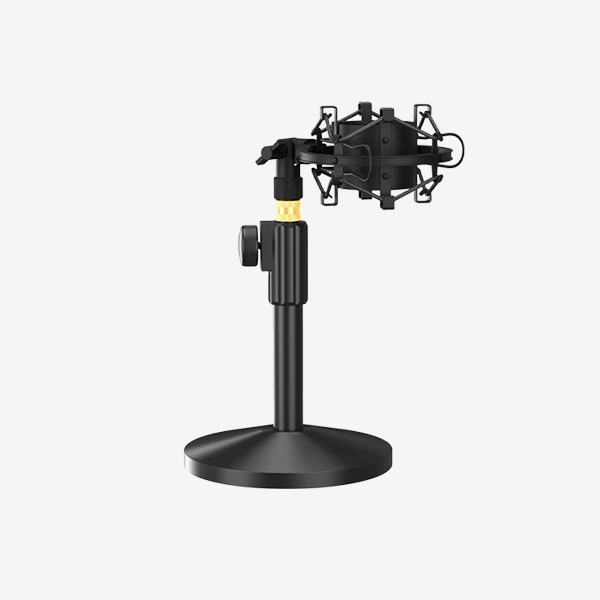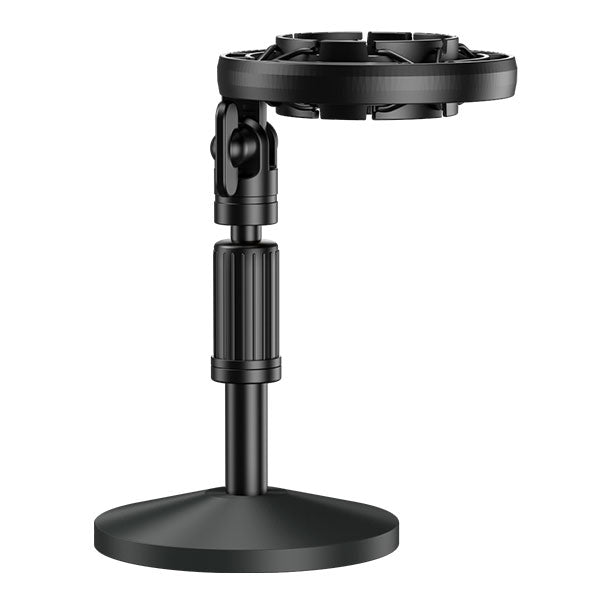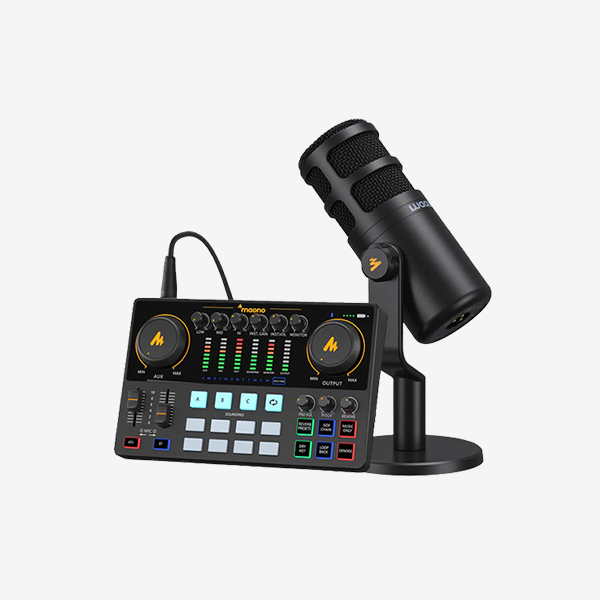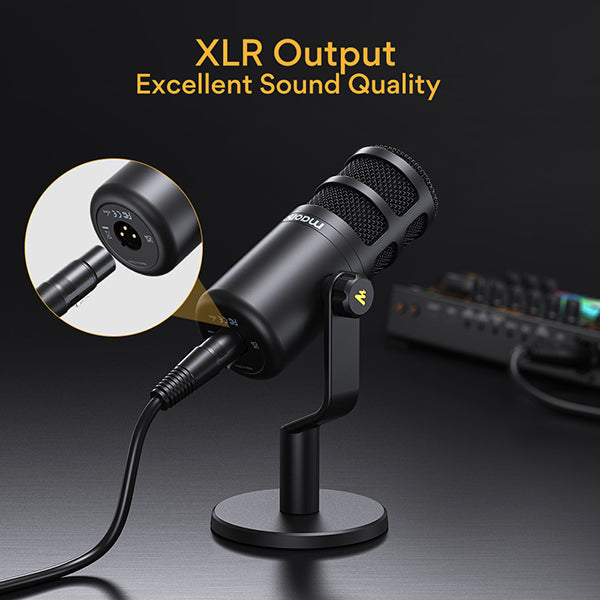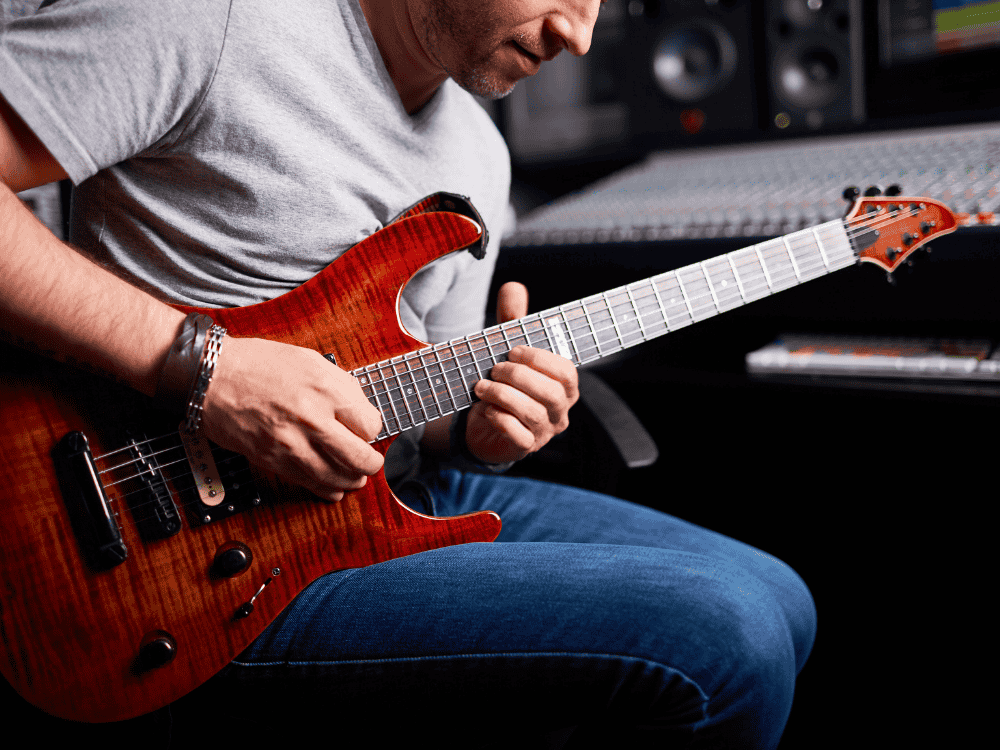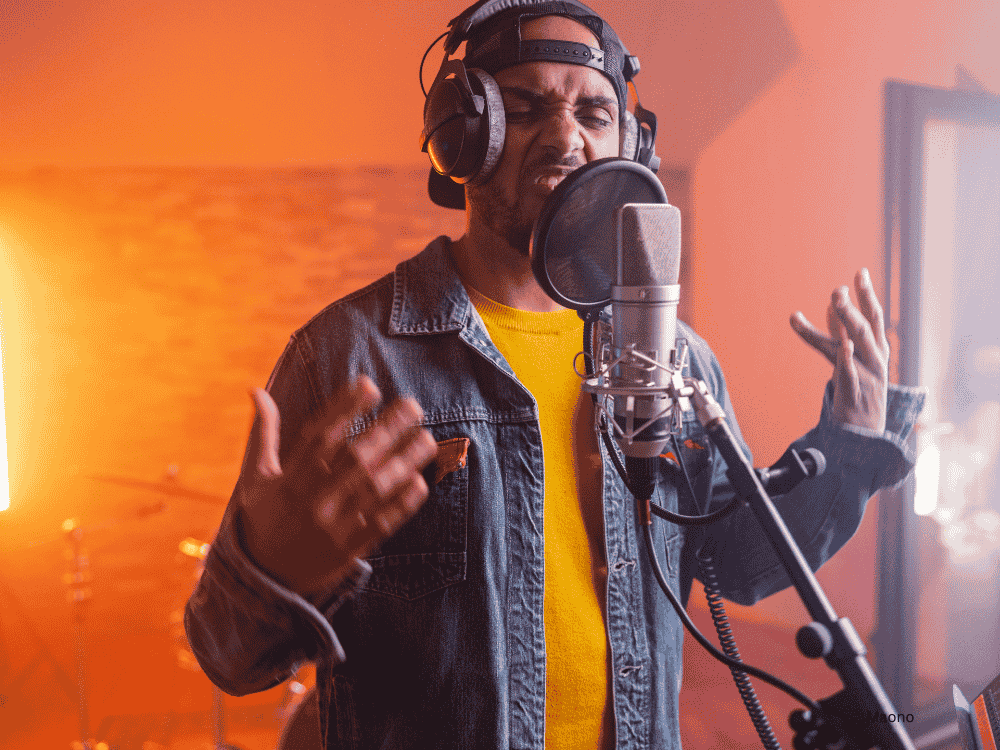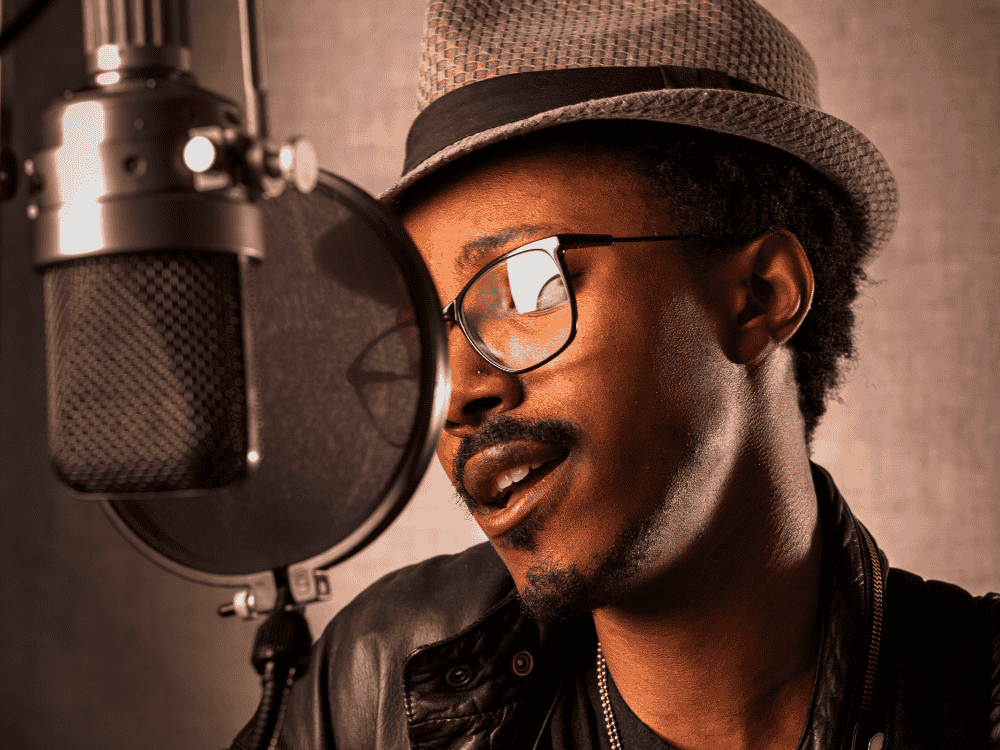Importance of choosing the right microphone for recording vocals
As a vocalist, your microphone is the most essential tool for capturing your voice with clarity and precision. Choosing the right recording microphone for vocals can make a significant difference in the quality of your recordings and help you unleash your vocal potential. With the advancements in technology, there are a plethora of options available in the market. However, it can be overwhelming to find the right microphone suitable for recording. In this article, I will guide you through the process of selecting the best microphone to record vocals, and we'll also explore advanced techniques like recording vocals with 2 mics to help you achieve professional-quality sound.
How to Choose the Best Microphone to Record Vocals
To choose the best microphone to record vocals, you need to consider several factors. Firstly, you need to determine whether you require a condenser or dynamic microphone. Condenser mics are known for their sensitivity and accuracy, making them ideal for capturing the nuances of vocals. On the other hand, dynamic mics are more rugged and can handle higher sound pressure levels, making them suitable for live performances or recording in a noisy environment.
Another crucial factor to consider is the polar pattern of the microphone. The polar pattern determines the directionality of the microphone's sensitivity to sound. Popular polar patterns for vocal recording include cardioid, which captures sound from the front and rejects sound from the sides and rear, and omnidirectional, which captures sound from all directions. It is important to choose a polar pattern that suits your recording environment and desired sound.
The frequency response and frequency range of the microphone is essential to consider. Different microphones have different frequency response curves, which can impact the tonal characteristics of your vocals. Some microphones have a flat frequency response, while others may emphasize certain frequencies. Frequency range specifies the limits of the frequencies a microphone can capture. Understanding both the frequency range and frequency response is important to choose the right vocal recording microphone that complements your vocal style, ensuring that it captures your voice accurately, and enhances the way you sound.
Sound coloration is another factor in purchasing a microphone. It means a microphone changes the original sound by making some tones louder or softer than they really are. When evaluating sound coloration in a microphone, it's essential to: consider professional reviews, recommendations, and user feedback--it can provide insights into how a microphone's coloration affects different types of recordings.
Quick Buying Guide:
To select the best microphone for vocal recording, first determine your budget to narrow down your options to microphones within your price range. Consider your vocal style—whether it’s soft and intimate or powerful and dynamic—as different microphones (e.g., condenser vs. dynamic) suit various vocal characteristics. Finally, assess your recording environment; for a controlled studio setting, a condenser microphone offers detailed sound, while a dynamic microphone may be better for untreated spaces with background noise.
Microphone types: Condenser vs Dynamic
There are two main types of microphones that are commonly used for recording vocals: condenser and dynamic microphones. Each type has its own unique characteristics and is suited for different purposes.
Condenser mics are known for their sensitivity and accuracy in capturing vocals. They require an external power source, usually through phantom power, and are more delicate compared to dynamic mics. Condenser mics are ideal for capturing the subtle nuances and details of vocals, making them a popular choice for studio recordings. They have a wide frequency response and can capture a broader range of tones.
On the other hand, dynamic mics are more rugged and can handle higher sound pressure levels. They do not require external power and are more durable compared to condenser mics. Dynamic microphones are commonly used for live performances or in environments where there is a lot of background noise. They have a narrower frequency response but can provide a more robust and punchy sound.
Read this article: Cardioid Mic vs Condenser: Key Differences, Best Uses, and FAQs to learn more about specific scenarios when to use condenser and dynamic microphones.
Top 10 microphones for recording vocals in 2024
1. Shure SM58
The Shure SM58 is a legendary dynamic microphone known for its reliability and durability. It has a tailored frequency response for vocals and provides excellent sound isolation.
2. Maono PM422
Maono PM422 is an all-in-one USB condenser microphone with a boom arm known for its’ easy plug-and-play and one-click mute and professional sound, it is quite a try for most beginners who just like to try vocal recording at home.
3. Neumann U87
The Neumann U87 is a high-end condenser microphone that is widely regarded as one of the best microphones for recording vocals. It has a smooth and natural sound with a wide frequency response.
4. Audio-Technica AT2020
The Audio-Technica AT2020 is a budget-friendly condenser microphone that offers exceptional audio quality. It has a cardioid polar pattern and a wide dynamic range.
5. Rode NT1
The Rode NT1 is a quiet condenser microphone that provides a clean and detailed sound. It has a wide frequency response and a low self-noise level.
6. Sennheiser e835
The Sennheiser e835 is a dynamic microphone that offers a clear and natural sound. It has a cardioid polar pattern and a rugged build.
7. Electro-Voice RE20
The Electro-Voice RE20 is a dynamic microphone that is popular among broadcasters and podcasters. It has a smooth and balanced sound with excellent off-axis rejection.
8. Blue Yeti
The Blue Yeti is a versatile USB microphone that is perfect for home vocal recording. It has multiple polar patterns and a built-in headphone amplifier.
9. Maono PM500T

As a professional-grade XLR condenser microphone designed for singing and vocals recording, music creation, and sound productions. PM500 XLR microphone can always easily capture any audible sound naturally and engagingly. From the recording of the drum to the string instrument, which is always an idea choice for most creators.
10. DM30RGB

DM30RGB USB condenser microphone is always a best budget vocal mic for most beginners who don't have enough budget. it is a microphone worth its price and it is definitely a choice for recording vocals at home as well for most beginners.
Now that we have explored the top 10 microphones for recording vocals, let's dive deeper into each microphone and understand their unique features and characteristics.
1. Shure SM58
The Shure SM58 is a legendary microphone that has stood the test of time. It is known for its durability and reliability, making it a popular choice for live performances. The SM58 has a tailored frequency response for vocals, with a slight boost in the midrange to enhance presence. It also features a built-in spherical pop filter to reduce plosive sounds.
2. Maono PM422
The PM422 is a versatile condenser microphone that is widely used in professional studios. It offers a cardioid polar pattern that allows for flexibility in different recording situations at home. The PM422 can easily capture the nuances of vocals with precision. It also features a professional sound chipset 192KHZ/24BIT and a 16mm electret condenser transducer that comes with detailed sound. Ideal for musicians, streamers, podcasters, vocal recording and other content creators. It is a microphone that comes with a stand and filter. If you are new to vocals recording, it is a very worthy choice.
3. Neumann U87
The Neumann U87 is a high-end condenser microphone that is widely used in professional studio recording. It has a smooth and natural sound with a wide frequency response. The U87 offers three polar patterns - cardioid, omnidirectional, and figure-8, providing flexibility in different vocal recording situations. It also has a low self-noise level, allowing for clean and detailed recordings.
4. Audio-Technica AT2020
The Audio-Technica AT2020 is a budget-friendly condenser microphone that delivers exceptional audio quality. It features a cardioid polar pattern, which helps to isolate the vocals and reduce background noise. The AT2020 has a wide dynamic range, allowing for a more expressive and nuanced performance. It is a versatile mic for recording studio live performances.
5. Rode NT1
The Rode NT1 is a quiet condenser microphone that provides a clean and detailed sound. It has a wide frequency response, capturing a broad range of tones. The NT1 has a low self-noise level, making it suitable for capturing subtle details in vocals. It also features a built-in pop shield and shock mount, reducing unwanted noise and vibrations.
6. Sennheiser e835
The Sennheiser e835 is a dynamic microphone that offers a clear and natural sound. It has a cardioid polar pattern, which helps to isolate the vocals and reduce feedback. The e835 has a rugged build, making it suitable for live performances. It also features a hum-compensating coil, reducing electromagnetic interference.
7. Electro-Voice RE20
The Electro-Voice RE20 is a dynamic microphone that is widely used in broadcast and podcasting applications. It has a smooth and balanced sound, with excellent off-axis rejection. The RE20 features a Variable-D technology, which helps to maintain consistent sound quality even when the vocalist moves off-axis. It also has a built-in pop filter and shock mount to reduce unwanted noise and vibrations.
8. Blue Yeti
The Blue Yeti is a versatile USB microphone that is perfect microphone for recording vocals at home. It features multiple polar patterns - cardioid, omnidirectional, bidirectional, and stereo, allowing for flexibility in different recording situations. The Yeti has a built-in headphone amplifier, making it convenient for monitoring the vocal recordings in real-time. It also features a gain control and mute button on the microphone itself, providing easy access to adjust the sound.
9. Maono PM500T
PM500T is known for its custom-designed 34mm gold spluttered condenser capsule. and offers a wide dynamic range of 20Hz - 20KHz, unmatched clarity, and ultra-precise cardioid polar pattern. It offers a detailed, rich, smooth, and pleasing sound, which is superb for both studio and home vocalrecordings. The circuit design utilizes premium components from top-tier manufacturers and a tailor-made permalloy audio signal transformer to provide low self-noise and exceptional sound capturing. This is a professional studio-grade XLR large-diaphragm condenser microphone designed for vocalists, music instrument performers, podcasters, live streamers, and audio professionals.
10. Maono DM30RGB
For novice users who just want to try recording, this is a suitable USB microphone, equipped with a Cardioid pattern with excellent off-axis noise suppression performance and works with Maono link software, allows you to adjust mic gain, headphone volume, mic tone, RGB lighting customization, equalizer, limiter, compressor, and more you like. With a metal body design, the DM30RGB USB mic comes with a high sensitivity condenser microphone core, pickup 24bit/48kHz high sampling rate. for the price only $49.99, it is a perfect recording microphone for beginners.
Here's a list of the other best microphones to record vocals that are worth mentioning::
1. Shure SM7B
Mic Type: Dynamic
Frequency Range: 50 Hz to 20 kHz
Polar Pattern: Cardioid
- Pros:
✅ Excellent for vocal recordings
✅ Great at rejecting background noise
✅ Sturdy and durable build
✅ Built-in air suspension shock isolation minimizes mechanical noise
- Cons:
❌ Requires a lot of gain, often needing a preamp or signal booster
❌ Heavier and larger, requiring a strong mic stand
2. AKG C414 XLII – Best Choice of microphone for recording vocals
Mic Type: Condenser
Frequency Range: 20 Hz to 20 kHz
Polar Pattern: Multiple patterns (Omnidirectional, Cardioid, Figure-8, and more)
- Pros:
✅ Versatile with multiple polar patterns
✅ High sensitivity and detailed sound
✅ Low self-noise
✅ Excellent for a variety of instruments and vocals
- Cons:
❌ Expensive
❌ Requires phantom power
3. AKG C214 – Best budget-friendly, high-quality vocal microphone
Mic Type: Condenser
Frequency Range: 20 Hz to 20 kHz
Polar Pattern: Cardioid
- Pros:
✅ Affordable compared to higher-end models
✅ High-quality sound with detailed clarity
✅ Durable and rugged design
✅ Pad and low-cut filter for flexibility
- Cons:
❌ Less versatile with only one polar pattern
❌ Requires phantom power
4. Aston Microphones Origin – Best in Style Microphone for recording vocals
Mic Type: Condenser
Frequency Range: 20 Hz to 20 kHz
Polar Pattern: Cardioid
- Pros:
✅ Unique and stylish design
✅ High-quality build materials
✅ Clear and natural sound
✅ Affordable for the quality it offers
- Cons:
❌ Limited to one polar pattern
❌ Requires phantom power
5. IK Multimedia iRig Stream Mic Pro
Mic Type: Condenser
Frequency Range: 20 Hz to 20 kHz
Polar Pattern: Cardioid, Omnidirectional, Figure-8, Stereo
- Pros:
✅ Versatile with multiple polar patterns
✅ Integrated streaming and recording features
✅ Compact and portable
✅ Easy to use with mobile devices and computers
- Cons:
❌ Limited professional-grade sound quality
❌ May not be as durable as other options
6. AKG C414
Mic Type: Condenser
Frequency Range: 20 Hz to 20 kHz
Polar Pattern: Multiple patterns (Omnidirectional, Cardioid, Figure-8, and more)
- Pros:
✅ Extremely versatile with multiple polar patterns
✅ High sensitivity and detailed sound
✅ Low self-noise
✅ Great for a wide range of applications
- Cons:
❌ Expensive
❌ Requires phantom power
7. Behringer TM1 Condenser Microphone
Mic Type: Condenser
Frequency Range: 20 Hz to 20 kHz
Polar Pattern: Cardioid
- Pros:
✅ Affordable
✅ Comes with accessories like shock mount and pop filter
✅ Decent sound quality for the price
- Cons:
❌ Not as high quality as more expensive mics
❌ Limited to one polar pattern
❌ Requires phantom power
8. AKG P120 Large Diaphragm Condenser Microphone
Mic Type: Condenser
Frequency Range: 20 Hz to 20 kHz
Polar Pattern: Cardioid
- Pros:
✅ Affordable
✅ Good build quality
✅ Clear sound suitable for various recordings
✅ Pad and low-cut filter
- Cons:
❌ Limited to one polar pattern
❌ Requires phantom power
9. MXL 990
Mic Type: Condenser
Frequency Range: 30 Hz to 20 kHz
Polar Pattern: Cardioid
- Pros:
✅ Affordable
✅ Warm and vintage sound
✅ Sturdy construction
✅ Comes with shock mount and case
- Cons:
❌ Limited to one polar pattern
❌ Requires phantom power
❌ Not as detailed as higher-end microphones
Best Practices and Tips in Recording Vocals with 2 Mics
When recording vocals with 2 mics, you can achieve a richer and more versatile sound. This technique is particularly useful for capturing both the direct vocal performance and the natural room acoustics. Here’s a quick guide:
- Techniques: Use one mic for the main vocal and another for backing vocals or ambient sound.
- Placement: Proper microphone placement is crucial to avoid phase issues.
- Phase Issues: Ensure that your mics are in phase to prevent any sound cancellation.
Choosing the Right Mic
Secondary Mic: A dynamic microphone like the PD200XS complement the condenser by adding warmth and reducing background noise.
Placement Techniques:
Primary Mic Placement: Position the condenser mic directly in front of the singer at a distance of 6-12 inches.
Secondary Mic Placement: Place the dynamic mic slightly off-axis or at a different height to capture additional vocal characteristics and ambient sounds.
Combining the Signals:
- Use a mixer or audio interface to blend the signals from both mics. This allows you to adjust the balance and achieve the desired sound profile.
- Implementing this technique requires careful planning and testing, but the results can be a significant improvement in the richness and fullness of your vocal recordings.
Recommended video:
Best microphones for different vocal styles
Different vocal styles require different microphones to capture the unique characteristics and nuances of each style. Let's explore the best microphones for some popular vocal styles:
- Pop and R&B
For pop and R&B vocals, a microphone that can capture the nuances and details of the vocals is essential. Condenser mics like the Neumann U87 or PM422 are ideal for these genres, as they provide a smooth and detailed sound.
- Rock and Metal
Rock and metal vocals often require a microphone that can handle high sound pressure levels and provide a punchy sound. Dynamic mics like the Shure SM58 or Electro-Voice RE20 are popular choices for these genres, as they can handle the aggressive and powerful vocals.
- Jazz and Blues
Jazz and blues vocals require a microphone that can capture the warmth and richness of the vocals. Condenser mics like the Audio-Technica AT2020 or Aston Origin are suitable for these genres, as they provide a warm and vintage sound.
- Classical and Opera
Classical and opera vocals require a microphone that can capture the full range and dynamics of the vocals. Condenser mics like the Neumann U87 or AKG C414 are commonly used for these genres, as they can capture the subtle nuances and details of the vocals.
- Singing & dubbing
As a singer or voice actor, it is very important to choose a studio microphone that can best display your voice. As a relatively professional recording vocals microphone, the Maono PM500T Microphone XLR Microphone is definitely a more suitable choice.
- Hip-Hop and Rap
Hip-hop and rap vocals require a microphone that can capture the clarity and presence of the vocals. Dynamic mics like the Shure SM58 or PM500T are popular choices for these genres, as they provide a clear and natural sound.
Other Budget-friendly options for recording vocals
Recording vocals on a budget doesn't mean compromising on quality. There are several budget-friendly vocals recording microphones available in the market that offer excellent audio quality. Here are some options to consider:
- DM30RGB
The Maono DM30RGB is a best budget-friendly condenser microphone that delivers exceptional audio quality. It has a cardioid polar pattern and a wide dynamic range, making it suitable for vocals.
- PM422
The PM422 is an affordable condenser microphone that offers a warm and detailed sound. It has a cardioid polar pattern and a low-cut filter, providing versatility in different recording situations.
- A04
A04 is a classic USB microphone that features a good cardioid polar pickup pattern, high output, and low self-noise function, compatible with Windows, Mac, and iOS. which is easy to install, and set up, and suitable for vocal recording and also in podcasting, it is quite a good choice for most beginners and professionals. If you don't have enough budget for PM422, it is also a recording mic with boom arm choice for beginners.
Microphone accessories for better vocal recording
In addition to choosing the right mic for vocals recording, there are several accessories that can enhance the quality of your vocal recordings. Here are some essential accessories to consider:
A pop filter helps to reduce plosive sounds caused by the fast-moving air during vocal recordings. It is placed in front of the microphone to act as a barrier between the vocalist and the microphone.
A shock mount helps to isolate the microphone from vibrations and handling noise. It suspends the microphone in a cradle, reducing unwanted noise and vibrations.
A sturdy mic stand is essential for positioning the microphone at the optimal height and angle. It helps to reduce handling noise and provides stability during vocal recordings.
- Reflection filter
A reflection filter helps to reduce room reflections and improve the clarity of the vocals. It is placed behind the microphone to absorb and diffuse sound waves.
If you are using a condenser microphone or a dynamic microphone with an XLR connection, you will need an XLR cable to connect the microphone to your audio interface or mixer.
How to set up and optimize your microphone for vocal recording
Setting up and optimizing your microphone for vocal recording is crucial to achieve the best sound quality. Here are some steps to follow:
1. Choose the right microphone
Refer to the earlier sections of this article to choose the right vocal mic for your needs and preferences.
2. Position the microphone
Position the microphone at a comfortable height and angle. It should be placed around 6-12 inches away from your mouth for optimal sound capture.
3. Use a pop filter
Attach a pop filter to the microphone to reduce plosive sounds. Position it around 2-3 inches away from the microphone to effectively reduce plosives.
4. Set the gain level
Adjust the gain level on your audio interface or mixer to ensure that the input signal is neither too low nor too high. Aim for a clean and balanced signal.
5. Test and adjust
Test your microphone setup by recording a sample vocal. Listen back to the recording and make any necessary adjustments to the microphone position, gain level, or other settings.
6. Optimize the recording environment
Make sure to record in a quiet environment to minimize background noise. Consider using acoustic treatment, such as foam panels or diffusers, to improve the acoustics of your recording space.
7. Practice microphone technique
Experiment with different microphone techniques, such as varying the distance from the microphone or adjusting the angle, to find the best sound for your vocals.
For more on microphone techniques, check out our article on: What Recording Microphone for PC is Highly Recommended?
Recommended video:
Common FAQs
1. What do you need in a vocal mic?
For a vocal mic, you need:
Clarity and Detail: To accurately capture the nuances of the voice.
Appropriate Polar Pattern: Usually cardioid, to focus on the voice and reject background noise.
Low Self-Noise: To avoid adding hiss to the recording.
Durability: To withstand regular use.
Compatibility: Ensuring it works with your audio interface and setup.
2. Vocal microphones – flat sound or colored sound?
Flat Sound: Provides a natural and accurate representation of the voice, ideal for capturing a true-to-life recording.
Colored Sound: Enhances certain frequencies to add warmth, presence, or other desirable characteristics, often preferred for specific vocal styles or genres.
Conclusion: Find your perfect microphone and unleash your vocal potential

Choosing the right microphone for recording vocals is crucial in unleashing your vocal potential. With the top 10 microphones for recording vocals in 2024, you have a wide range of options to suit your specific needs and budget.
Consider the factors we discussed, such as polar pattern, frequency response and frequency range, sensitivity, durability, sound coloration, and budget, when selecting your vocal recording microphone. Additionally, understanding the differences between condenser and dynamic mics will help you make an informed decision.
Remember to match your microphone choice to your vocal style for the best results. Whether you're a pop singer, a classical vocalist, or an aspiring hip-hop artist, there is a microphone that will capture the unique qualities of your voice.
Investing in microphone accessories, such as a pop filter, shock mount, reflection filter, and microphone stand, will further enhance your vocal recordings and improve their overall quality.
Finally, take the time to set up and optimize your microphone for recording. Experiment with positioning, use a pop filter, enable phantom power if necessary, and monitor your recordings in real-time. These steps will ensure that you capture the true essence of your voice.
Now, armed with the knowledge of the best microphones for recording vocals in 2024, it's time to find your perfect microphone and unleash your vocal potential. Happy recording!






















